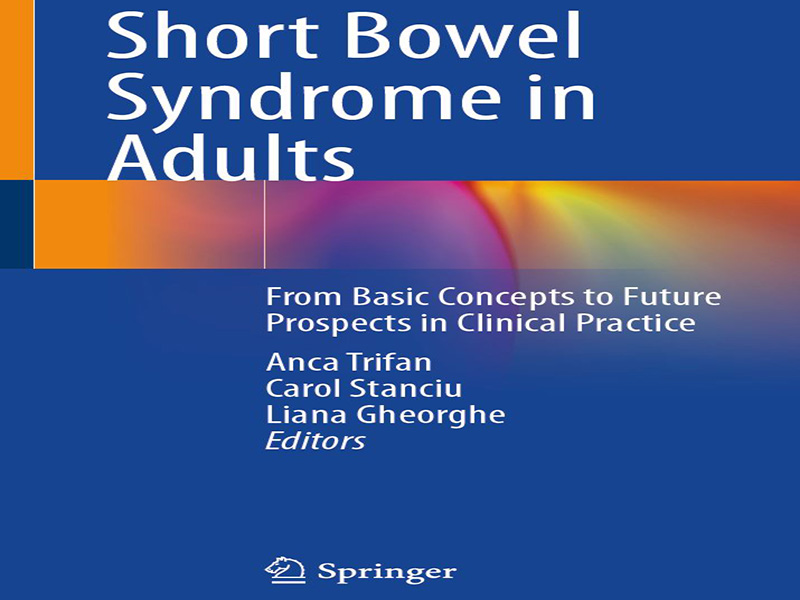- عنوان کتاب: Short Bowel Syndrome in Adults
- نویسنده: Anca Trifan, Carol Stanciu, Liana Gheorghe
- حوزه: سندروم روده
- سال انتشار: 2025
- تعداد صفحه: 281
- زبان اصلی: انگلیسی
- نوع فایل: pdf
- حجم فایل: 5.03 مگابایت
نقش روده هضم و جذب مواد مغذی و مایعات است؛ بخشهای مختلف روده نقشهای خاصی در این فرآیند دارند. کاهش سطح عملکردی روده و زمان انتقال مواد غذایی با برداشتن بخشهایی از روده از طریق جراحی، هضم را مختل میکند و میتواند منجر به درجات مختلفی از سوء جذب شود که منجر به اسهال مزمن، استئاتوره، کمبود درشت مغذیها و ریزمغذیها، از دست دادن مایعات و عدم تعادل الکترولیتها میشود. نارسایی مزمن روده (CIF) اخیراً توسط انجمن اروپایی تغذیه تزریقی و رودهای (ESPEN) [1] به عنوان «کاهش مداوم عملکرد روده به زیر حداقل لازم برای جذب درشت مغذیها و/یا آب و الکترولیتها، به طوری که برای حفظ سلامت و/یا رشد، در بیماری که از نظر متابولیکی پایدار است، مکملهای داخل وریدی (IVS) مورد نیاز است» تعریف شده است، در حالی که اصطلاح «نارسایی روده» (یا «نقص روده» برای زبانهایی که «نارسایی» و «نارسایی» معنای یکسانی دارند) مواردی را توصیف میکند که اگرچه عملکرد روده تحت تأثیر قرار میگیرد، اما نیازی به IVS نیست زیرا بیمار میتواند طول روده از دست رفته را با مکانیسمهای مختلف (پرخوری، مشاوره رژیم غذایی و مداخلات تغذیهای، دارویی یا جراحی) جبران کند. CIF به پنج وضعیت پاتوفیزیولوژیکی طبقهبندی میشود، یعنی سندرم روده کوتاه، فیستول روده، اختلال حرکتی روده، انسداد مکانیکی و بیماری گسترده مخاط روده کوچک. سندرم روده کوتاه (SBS) یک وضعیت بالینی است که در اثر جراحی گسترده برداشتن روده کوچک ایجاد میشود و روده کوچک باقیمانده در پیوستگی کمتر از 200 سانتیمتر مربع است و علت اصلی نارسایی مزمن روده است – 64.4٪ موارد.
The role of the gut is to digest and absorb nutrients and fluids; different parts of the gut have specific roles in this process. Reduction of functional intestinal area and transit time by surgically removing parts of the bowel impairs digestion and can lead to various degrees of malabsorption, resulting in chronic diarrhoea, steatorrhoea, macro- and micronutrient deficiencies, fluid losses, and electrolyte imbalances. Chronic intestinal failure (CIF) was recently defined by the European Society for Parenteral and Enteral Nutrition (ESPEN) [1] as “persistent reduction of the gut function below the minimum necessary for the absorption of macronutrients and/or water and electrolytes, such that intravenous supplementation (IVS) is required to maintain health and/or growth, in a patient who is metabolically stable,” whereas the term “intestinal insufficiency” (or “intestinal deficiency” for those languages where “insufficiency” and “failure” have the same meaning) describes the cases in which although the gut function is affected there is no need for IVS because the patient can compensate for the missing bowel length by various mechanisms (hyperphagia, dietary counselling, and nutritional, pharmacological, or surgical interventions). CIF is classified into five pathophysiological conditions, namely short bowel syndrome, intestinal fistula, intestinal dysmotility, mechanical obstruction, and extensive small bowel mucosal disease. Short bowel syndrome (SBS) is a clinical condition that results from extensive surgical resection of the small bowel, with residual small bowel in continuity being less than 200 cm and is the primary cause of chronic intestinal failure—64.4% of cases.
این کتاب را میتوانید از لینک زیر بصورت رایگان دانلود کنید:
Download: Short Bowel Syndrome in Adults




































نظرات کاربران